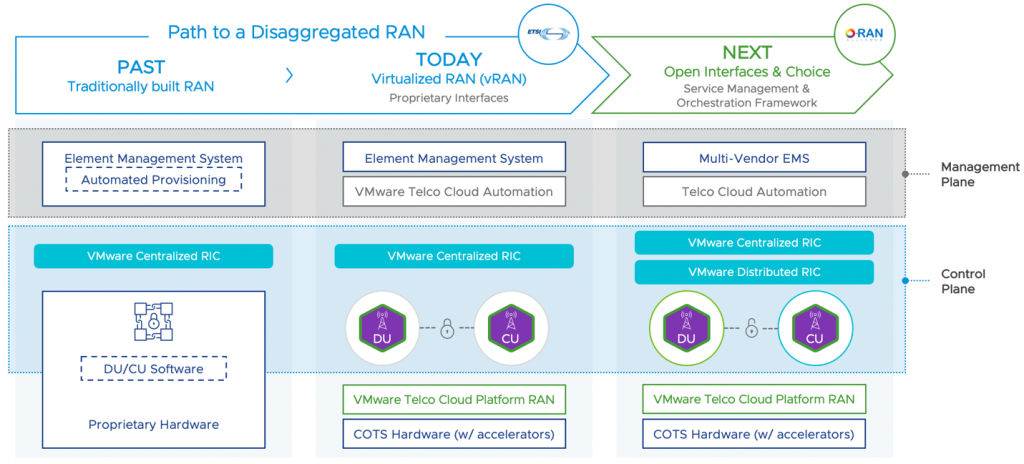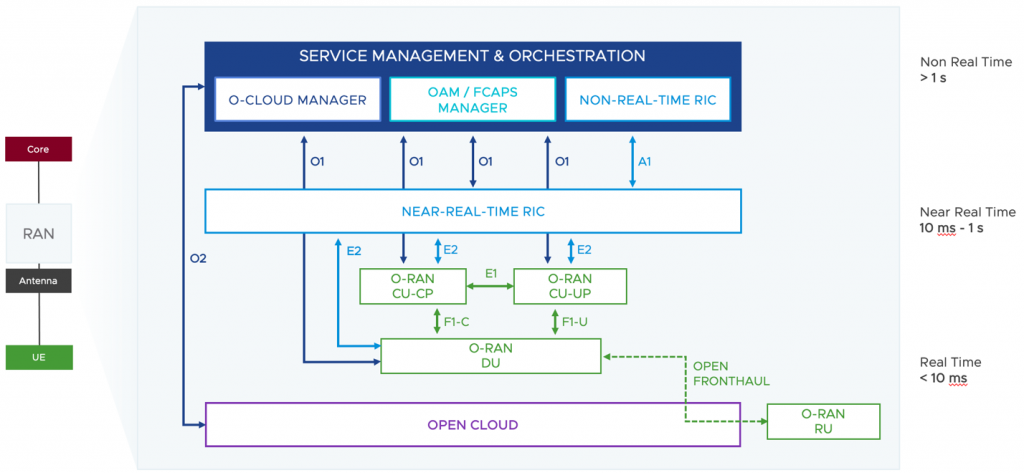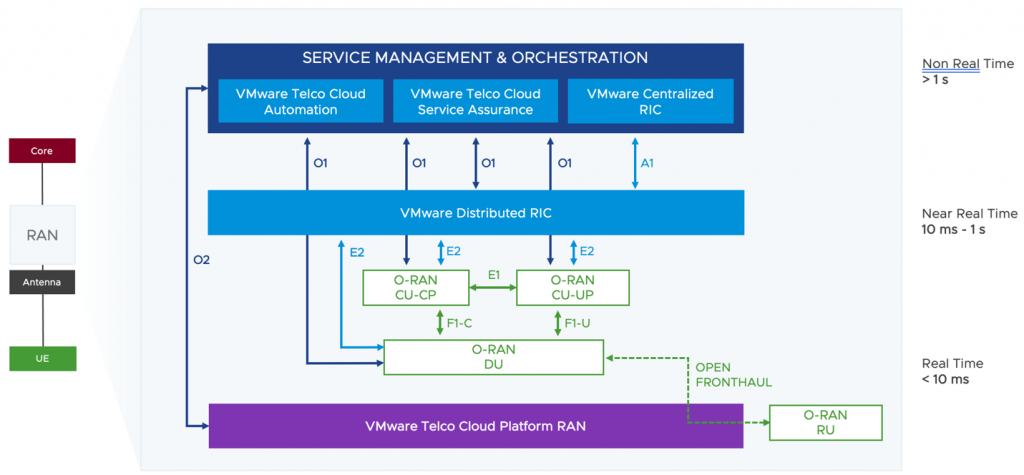For the past five-plus years, VMware has been methodically introducing new telco cloud solutions and changing expectations in the service provider industry about modernization. With an established footprint in telco cloud deployments globally, in recent years VMware has been expanding its capabilities to address the challenges in the disaggregation of the RAN.
With a horizontal platform that enables workload consistency from the core and the RAN to the public cloud, we’ve revealed what is possible – simplicity, speed, agility, and far-reaching automation. The objective is to enable our customers to modernize their entire networks, simplify their operations with end-to-end consistency, and further disaggregate their RAN.
But our customers’ network modernization journey doesn’t stop at the disaggregation of the RAN. The next phase is to make the RAN and the entire network programmable. This is the precise reason we have introduced VMware RAN Intelligent Controller (VMware RIC).
A concept defined by the O-RAN Alliance, the RIC is a powerful solution — it opens the RAN, which has been built with proprietary solutions for the past several decades. One of the key benefits of opening the RAN with the RIC is to allow new application developers to participate in this previously closed domain – to bring innovation to our customers faster. These innovative applications, many of which use AI and ML, are being infused into the RAN, making it easier to optimize and monetize the RAN.
Opening the RAN creates an ecosystem that lets service providers choose among a wide range of solutions, including open RAN infrastructure, disaggregated RAN functions, RIC as a platform, and applications. And a cloud-native architecture makes implementing those choices easier and faster than ever.
Open RAN, the RIC, and a Wave of Growth
The service providers industry is also driving the RIC forward. One analyst recently mentioned that there are now over two dozen RIC vendors. Even though that number potentially includes RAN vendors, SON vendors, and virtualization and cloud-native specialists like VMware, two dozen is a remarkable number considering that the RIC was just a concept a couple of years ago and that the momentum of open RAN is just picking up. This recent uptick mirrors the Session Border Controller market back in the mid 2000s or, more recently, the wave of growth in SD-WAN vendors, of which VMware is a leader, according to the 2021 Gartner Magic Quadrant for WAN Edge Infrastructure.
Just like with our SD-WAN and SASE solutions, VMware has the knowledge, resources, and expertise to become the leader in the RIC market. Why? Because we have already been helping our customers modernize their core and disaggregate their RAN. With VMware RIC, our customers and VMware together are heading toward open RAN and building programmable networks, end-to-end.
RIC SDK Partner Program
To succeed in this suddenly congested market, though, forming a rich and vibrant ecosystem plays a critical role. With the newly established RIC SDK partner program, VMware is making great strides on this front. As our ecosystem continues to grow, here are just a few examples of powerful new RAN applications we are providing access to through our RIC:
- Automated RAN Optimization rApps with Airhop
- Dual and optimized 4G and 5G connectivity with Cellwize
Support for Traditional and New RAN Environments
VMware RIC supports both near-real-time applications (xApps) and non-real-time applications (rApps). VMware Distributed RIC is our near-real-time RIC solution to support xApps, and VMware Centralized RIC is our non-real-time RIC solution to support rApps.
VMware Centralized RIC supports both traditional RAN and virtualized RAN environments, as shown in the diagram below. This support allows any service provider to take advantage of newly introduced RAN innovation through rApps now on their existing RAN infrastructure without having to wait to deploy O-RAN infrastructure. The ability of VMware Centralized RIC to support traditional RAN deployments also enables service providers to take the first step toward disaggregating the RAN and ultimately opening it up, making their networks and RAN modernization journey as smooth as possible.

Flexibility for the Service Management and Orchestration Layer
When it comes to opening the RAN, the O-RAN Alliance is leading the charge. At the highest level of the architecture defined by the O-RAN alliance, the Service Management and Orchestration (SMO) layer, as shown below, is responsible for RAN domain management. The architecture also shows the Open Cloud, functioning as the underpinning platform to support disaggregated RAN functions, and the near-real-time RIC.
Here are the three main functions of the SMO:
- O-Cloud Management and Orchestration
- OAM and FCAPS Management
- Non-real-time RIC

VMware has flexible solutions for the SMO components defined by the O-RAN alliance. The following diagram shows the mapping of VMware solutions to the O-RAN architecture. For service providers who want these components from one vendor, VMware can provide a packaged solution. For service providers who want to choose components separately, VMware can provide only the necessary components. If service providers choose to run the RICs in a hyperscaler’s environment, VMware supports that as well, as our RICs are architected as cloud-native microservices that are agnostic to the underpinning platform.

Multi-Cloud Metamorphosis Through Openness
VMware supports various RAN vendors and clouds, either running on our high-performance VMware Telco Cloud Platform RAN or in the cloud. Flexibility drives openness, and openness means more choices.
Our customers are taking important steps toward building the RAN with an open architecture. Vodafone has announced a RIC trial with VMware and Cohere Technologies, among other partners, doubling 5G spectral efficiency and cell site capacity through a MU-MIMO xApp. DISH is another example. Dish is testing our RICs to enable progressively smarter automation with machine learning analysis of RAN traffic and performance. VMware RIC is also enabling Bharti Airtel to easily customize and optimize its network, diversify its supply chain, and innovate faster, all of which accelerates its open RAN transformation.
For more information, check out the following resources:
- VMware RIC eBook
- VMware RIC SDK Demo
- VMware RIC Use Case eBook
- The RAN Transformation Explained
- RAN Workload Performance Is Equivalent on Bare Metal and vSphere
- VMware RIC product page
Discover more from VMware Telco Cloud Blog
Subscribe to get the latest posts sent to your email.








